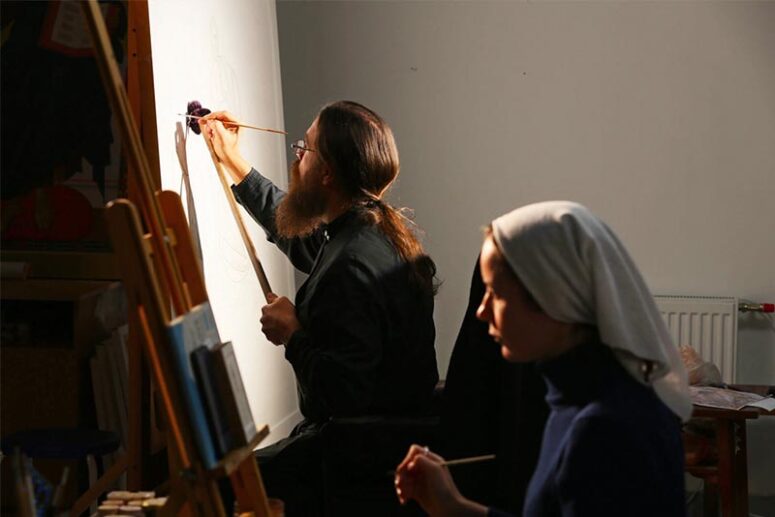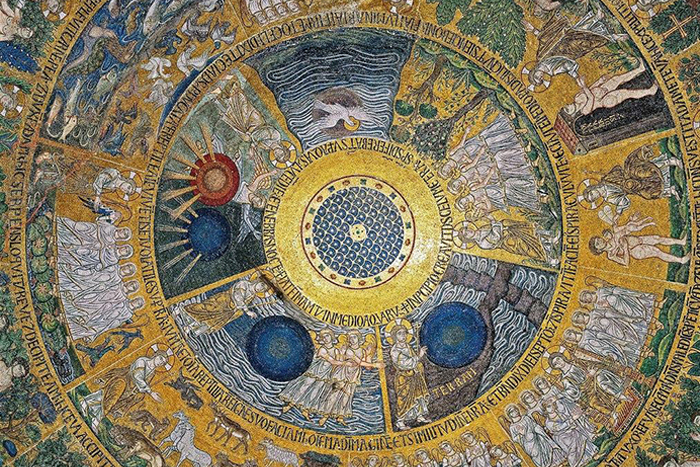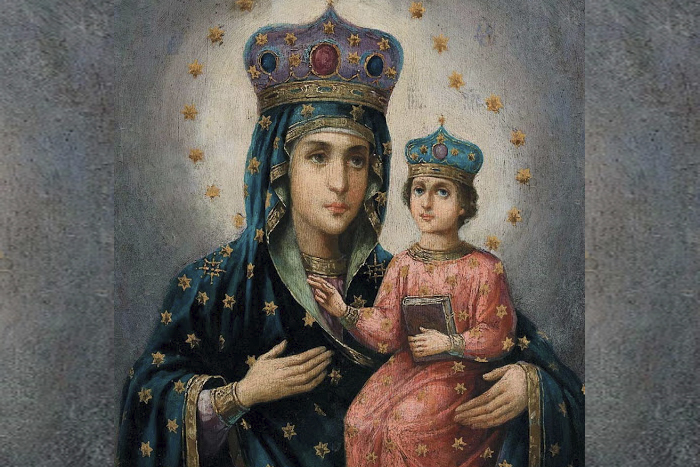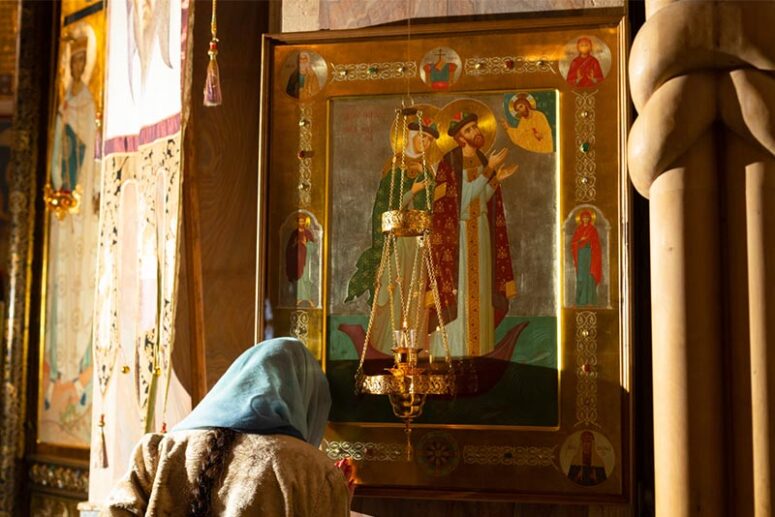
For over two decades, the icon-painting studio of St. Elisabeth Convent has been a crucible of creativity, forging original icons and pioneering new dimensions of iconography, particularly for lesser-known saints and contemporary martyrs. Inquisitive about the genesis of novel religious images and the hurdles faced by iconographers, we sought insight from Father Sergius Nezhbort, the venerable head of the workshop. Father Sergius unveils an enthralling tale connected to one of the icons conceived in their studio.
Father Sergius elaborates, “Our typical approach involves crafting icons of lesser-known saints by drawing inspiration from established depictions of saints within the same category—be they martyrs, venerable saints, or holy hierarchs. We carefully consider the saint’s historical context, the era they lived in, and the manifestations of their holiness. With this wealth of knowledge, we embark on creating a new and unique image. Remarkably, we often observe other iconographers drawing inspiration from our creations. A striking instance of this phenomenon occurred with our depiction of Saints Peter and Fevronia, which we originally crafted for the Church of the Reigning Icon of the Mother of God in our monastery.”
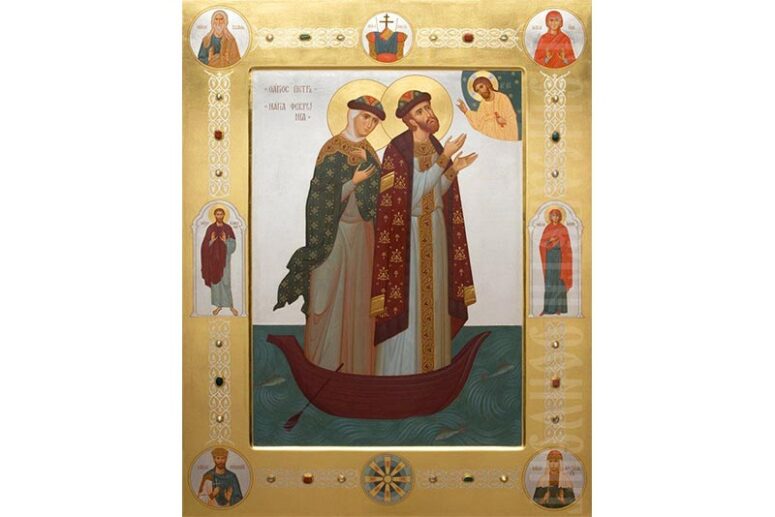
A Miraculous Union: Faith and Boldness Rewarded
Not long ago, a group of devout parishioners at the monastery sought to invoke the blessings of Saints Peter and Fevronia of Murom, patrons of wedded unions. Their aspiration was to find matrimonial bliss, and they embarked on a fundraising campaign to commission an icon dedicated to these revered saints. To deepen their spiritual connection, they gathered regularly to recite the akathist, fervently beseeching the intercession of Saints Peter and Fevronia.
Amid this dedicated pursuit, Father Sergius Nezhbort, the creative force behind the icon-painting studio, proposed an inspired notion – to evolve the iconography of these saints, imbuing it with a richer portrayal of family safeguarding. The result was a stunning rendition of the saints, with three additional saintly couples adorning its margins. Among them, the righteous Adam and Eve, the first couple and progenitors of humanity, graced the icon, symbolizing the beginnings of marital relationships. The righteous Joachim and Anna, through the birth of the Theotokos, marked the dawn of a new era in family life. And as a testament to the enduring and inspirational power of holy unions, the icon featured the royal Passion Bearers, Nicholas and Alexandra, whose loving correspondence serves as a timeless guide for couples.
With the icon completed, a weekly akathist service was established in its honor. The faith and courage of these young women who had set out to commission and gift this icon to the church were richly rewarded, as all of them soon found the joy of wedded bliss.

Emergence of a new iconographic type of Saints Peter and Fevronia
The uniqueness of the new icon extends beyond the inclusion of other married couples of saints.
“At that time, only two iconographies of these saints were known: in princely robes or monastic vestments (as Peter and Fevronia took monastic tonsure at the end of their lives),” says Father Sergius. “But since this icon was created for lay people who wanted a family life, I chose to depict the couple in princely robes. As this icon was intended for laypeople seeking a family life, I chose to depict the couple in princely robes.”
The audacious idea of placing the couple on a boat emerged. Despite the fact that Peter and Fevronia were not seafarers, this unique image symbolizes their journey through the tumultuous sea of worldly existence, akin to the biblical story of Noah’s Ark, where they find salvation amidst a sinful world.
“To depict them in a boat without a meaningful rationale would have been overly audacious,” Father Sergius reflects. “In collaboration with Natalia, the iconographer who played a significant role in this creative process, we decided to read the Akathist to these saints. There, we discovered the line that influenced our final decision: ‘You have adorned yourselves in the armor of Christ’s faith, and through the serenity of your souls, you have conquered the tumultuous sea of worldly existence, arriving at the tranquil haven of salvation. Through your intercessions, guide us likewise to this blessed destination.’ With these words in mind, we painted the icon as intended.”
Now, thanks to the Internet, we see that this image continues to thrive; other icon painters have started to replicate it. Our workshop regularly receives orders for icons of the Saints in this style. No one asks, ‘Who came up with this?’ This iconography has taken root in the hearts of Orthodox believers and has become a part of the Church. For many years, I have led the Akathist to Blessed Peter and Fevronia in front of this icon in our church, and every time I sense that there’s no discord in its iconography. The image feels entirely natural, and today I can hardly envision it being any different.”

“It is important that the new image is accepted by the Church”.
If you think about it, icons were painted in a similar way in ancient times,” says the workshop leader. “They were not always copied; new images had to be created and an acceptable form had to be found for them. It is very important for an icon to be accepted by the Church. And this can only be understood after some time. As the decades go by, we can see that some images from earlier times have become an integral part of the Church. For example, it is hard to imagine that some iconographer just sat down and painted the Vladimir icon of the Mother of God. It seems that it has always been this way. There are many similar examples.
On the other hand, some icons have been written that have not been so widely spread, venerated or reproduced, and today only a few people know about them. This can be said of the controversial images of the past and the works of some modern iconographers. A person has shown creativity, has introduced something of his own, and it seems interesting and sometimes impressive, but time has passed and the image has not taken root in the Church.
That’s why it is necessary to look for the right form. It is a good thing if a person has the right inner understanding of creativity in icon painting. Nevertheless, it is important that the icon is not just a reproduction of something from the past, but a living language of the Church. To do this, one should not only look at the past, but live today and think about the future, recognising certain risks and not going to extremes.”
